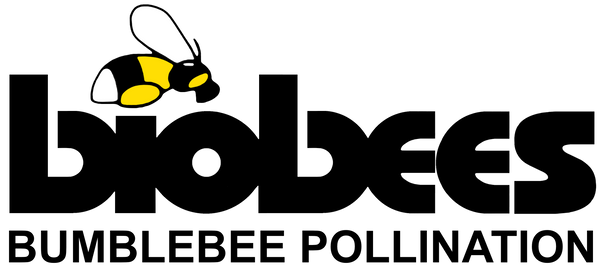Watermelon plants (Citrullus lanatus) bear both male and female flowers on the same plant (e.i. monoecious), although a few varieties do have perfect flowers (with both male and female organs) alongside male flowers. Nectar is produced at the base of the corolla. Pollen is generally released before the flower opens, however its stickiness prevents it from being removed by wind or vibration. Flowers open within two hours after sunrise, and while female flowers remain receptive for as long as they are open, they are most receptive between 9 and 10am. Flowers close in the afternoon, and will only reopen if they have not been pollinated.
Watermelons are self-fertile and there are no detrimental effects to fruit or yield from self-pollination or benefits from cross-pollination. Watermelons require the services of a pollinator, such as a bumblebee. In studies where flowers were bagged to prevent the pollination services of insects, 100% of the flowers aborted. In North America, it was estimated that it takes on average 6 visits per flower from honeybees to reduce fruit abortion, whereas a single bumblebee visit is sufficient! Pollen grains are sticky and easily collected and deposited on receptive stigmas (♀) by hairy bumblebees, and each stigma requires a minimum of 1000 pollen grains evenly spread over all three lobes to form a large, well shaped fruit. Deformations and loss of value occur if only one lobe is insufficiently pollinated.
Watermelons are self-fertile and there are no detrimental effects to fruit or yield from self-pollination or benefits from cross-pollination. Watermelons require the services of a pollinator, such as a bumblebee. In studies where flowers were bagged to prevent the pollination services of insects, 100% of the flowers aborted. In North America, it was estimated that it takes on average 6 visits per flower from honeybees to reduce fruit abortion, whereas a single bumblebee visit is sufficient! Pollen grains are sticky and easily collected and deposited on receptive stigmas (♀) by hairy bumblebees, and each stigma requires a minimum of 1000 pollen grains evenly spread over all three lobes to form a large, well shaped fruit. Deformations and loss of value occur if only one lobe is insufficiently pollinated.
Pollination Issues
The uneven or inadequate deposition of pollen on any of the three lobes of the stigma results in deformed, misshapen fruit. The use of bumblebees is an effective way to mitigate this.
Fruit set is more likely if the ovary is longer than 28mm when pollination occurs than when the ovary is less than 20mm long or smaller. Fruit set is higher in more vigorously growing plants.
Regular harvesting is required to optimise fruit set and yield, as the presence of unharvested ripe fruit have an inhibitory effect on the fruit set of other female flowers on the same plant.
Some watermelon flowers are thought to be a rich resource for bees, which might limit the number of flowers visited per foraging trip (and reducing the likelihood of good pollination). Increasing the density of bees creates added competition and flowers are visited more frequently (becoming more resource depleted), increasing the number of flowers visited by each bee during each foraging trip.
As with all flowering plants, the health and nutrition of the plant can affect pollen production and viability. Poor quality/quantities of pollen will have negative impacts on the bumblebee hive, and may lead to bumblebees searching for alternative pollen sources away from the crop, or to a reduction in the life of the hive. It is important to ensure that the plants are vigorous and healthy during flowering, and that their nutritional requirements are adequately met.
Fruit set is more likely if the ovary is longer than 28mm when pollination occurs than when the ovary is less than 20mm long or smaller. Fruit set is higher in more vigorously growing plants.
Regular harvesting is required to optimise fruit set and yield, as the presence of unharvested ripe fruit have an inhibitory effect on the fruit set of other female flowers on the same plant.
Some watermelon flowers are thought to be a rich resource for bees, which might limit the number of flowers visited per foraging trip (and reducing the likelihood of good pollination). Increasing the density of bees creates added competition and flowers are visited more frequently (becoming more resource depleted), increasing the number of flowers visited by each bee during each foraging trip.
As with all flowering plants, the health and nutrition of the plant can affect pollen production and viability. Poor quality/quantities of pollen will have negative impacts on the bumblebee hive, and may lead to bumblebees searching for alternative pollen sources away from the crop, or to a reduction in the life of the hive. It is important to ensure that the plants are vigorous and healthy during flowering, and that their nutritional requirements are adequately met.
Call us at the number below, or e-mail to enquire now!
